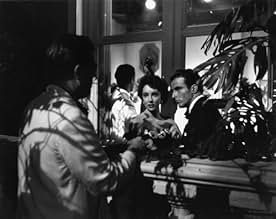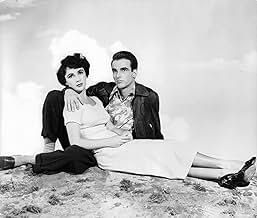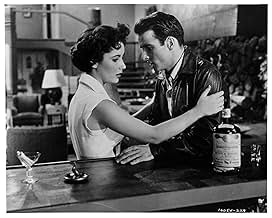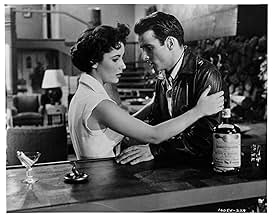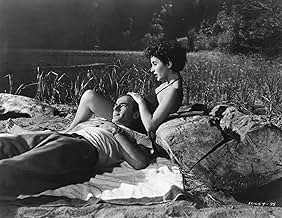A poor boy gets a job working for his rich uncle and ends up falling in love with two women.A poor boy gets a job working for his rich uncle and ends up falling in love with two women.A poor boy gets a job working for his rich uncle and ends up falling in love with two women.
- Won 6 Oscars
- 18 wins & 12 nominations total
Robert J. Anderson
- Eagle Scout
- (uncredited)
Gertrude Astor
- Bit Part
- (uncredited)
Featured reviews
Time does extraordinary things with greatness. If nothing else it confirms it. "A Place in the Sun" is a remarkable example of that theory. I rushed to buy a DVD after watching a BBC documentary on ELizabeth Taylor to celebrate her 75th birthday! In "A Place on the Sun" an Elizabeth Taylor barely out of her teens is paired with Montgomery Clift. She had been raised at MGM and groomed for movie stardom from day one. He was a method actor, complex, introspective and their coupling produced something that I'm tempted to call, unrepeatable. The actors own personal stories, their friendship, mutual love and respect made it possible for their communion to be so transcendental. To make things even more perfect, the film seems a love letter from director George Stevens to his stars and vice versa. Look at the opening credits and tell me if you've ever seen a more startling introduction to a character/star. The story of doomed love and descend into darkness is, without question, one of the best ever made.
The young and poor George Eastman (Montgomery Clift) leaves his religious mother and Chicago and arrives in California expecting to find a better job in the business of his wealthy uncle Charles Eastman (Herbert Heyes). His cousin Earl Eastman (Keefe Brasselle) advises him that there are many women in the factory and the basic rule is that he must not hang around with any of them.
George meets the worker of the assembly line Alice Tripp (Shelley Winters) in the movie theater and they date. Meanwhile, the outcast George is promoted and he meets the gorgeous Angela Vickers (Elizabeth Taylor) in a party at his uncle's house. Angela introduces him to the local high society and they fall in love with each other. However, Alice is pregnant and she wants to get married with George. During a dinner party at Angela's lake house with parents, relatives and friends, Alice calls George from the bus station and gives thirty minutes to him to meet her; otherwise she will crash the party and tells what has happened. George is pressed by the situation that ends in a tragedy.
"A Place in the Sun" is an unforgettable masterpiece by George Stevens and one of the best love stories ever made, with the perfect development of characters and situations. I watched this film for the first time on 14 June 2001 on cable television and yesterday I saw it again on a Paramount DVD with Extras telling details about the difficulties that George Stevens faced to bring Theodore Dreiser's novel "An American Tragedy" to a motion picture and casting. He had to sue Paramount to carry out the signed contract and get the agreed budget. Another interesting point is Shelley Winters, who was a sex symbol at that time, telling how she got the role of Alice Tripp. Elizabeth Taylor also tells funny things about her relationship with Montgomery Cliff. My vote is ten.
Title (Brazil): "Um Lugar Ao Sol" ("A Place in the Sun")
George meets the worker of the assembly line Alice Tripp (Shelley Winters) in the movie theater and they date. Meanwhile, the outcast George is promoted and he meets the gorgeous Angela Vickers (Elizabeth Taylor) in a party at his uncle's house. Angela introduces him to the local high society and they fall in love with each other. However, Alice is pregnant and she wants to get married with George. During a dinner party at Angela's lake house with parents, relatives and friends, Alice calls George from the bus station and gives thirty minutes to him to meet her; otherwise she will crash the party and tells what has happened. George is pressed by the situation that ends in a tragedy.
"A Place in the Sun" is an unforgettable masterpiece by George Stevens and one of the best love stories ever made, with the perfect development of characters and situations. I watched this film for the first time on 14 June 2001 on cable television and yesterday I saw it again on a Paramount DVD with Extras telling details about the difficulties that George Stevens faced to bring Theodore Dreiser's novel "An American Tragedy" to a motion picture and casting. He had to sue Paramount to carry out the signed contract and get the agreed budget. Another interesting point is Shelley Winters, who was a sex symbol at that time, telling how she got the role of Alice Tripp. Elizabeth Taylor also tells funny things about her relationship with Montgomery Cliff. My vote is ten.
Title (Brazil): "Um Lugar Ao Sol" ("A Place in the Sun")
Poor and uneducated George Eastman (Montgomery Clift) unwittingly sets a trap for himself when he takes an entry-level job at his rich uncle's factory, which has a prohibition on male employees dating female employees. He just can't resist one of the girls in his department, the pitiful and whiny Alice Tripp (wonderfully played by Shelley Winters). Eventually, George gets a promotion and is invited into the upper echelon of his uncle's social world, where he meets wealthy and beautiful Angela Vickers (a breathless Elizabeth Taylor). Naturally, he falls in love with Angela. But a complication with Alice leaves him unable to break off his relationship with her.
That's the setup for this George Stevens-directed film that plays rather like a modern Greek tragedy. Everything about "A Place In The Sun" is high quality: the production design, the lavish Edith Head costumes, the wonderful editing, and that great B&W cinematography with those marvelous close-up shots, and overlapping dissolves that cleverly advance the plot.
All three principal actors do a splendid job. And they get solid support from a top notch secondary cast that includes Raymond Burr and the interesting Anne Revere.
The story clearly plays up social class differences, with the haughty rich looking down their noses at common workers. The film's tone varies from romantic, to sad, to suspenseful. At mysterious Loon Lake where significant events occur, the cinematic atmosphere is heavy with anticipation. It's like something out of a Hitchcock thriller.
I've never cared much for sad love stories, and the film does seem a tad dated. Still, it's so well made it can be appreciated by most everyone but the terminally shallow. It has a powerful ending, one that accentuates the acting accomplishments of Clift and especially of Taylor. "A Place In The Sun" was nominated for nine academy awards, and winner of six. I'd say this is one time when Oscar voters got it right.
That's the setup for this George Stevens-directed film that plays rather like a modern Greek tragedy. Everything about "A Place In The Sun" is high quality: the production design, the lavish Edith Head costumes, the wonderful editing, and that great B&W cinematography with those marvelous close-up shots, and overlapping dissolves that cleverly advance the plot.
All three principal actors do a splendid job. And they get solid support from a top notch secondary cast that includes Raymond Burr and the interesting Anne Revere.
The story clearly plays up social class differences, with the haughty rich looking down their noses at common workers. The film's tone varies from romantic, to sad, to suspenseful. At mysterious Loon Lake where significant events occur, the cinematic atmosphere is heavy with anticipation. It's like something out of a Hitchcock thriller.
I've never cared much for sad love stories, and the film does seem a tad dated. Still, it's so well made it can be appreciated by most everyone but the terminally shallow. It has a powerful ending, one that accentuates the acting accomplishments of Clift and especially of Taylor. "A Place In The Sun" was nominated for nine academy awards, and winner of six. I'd say this is one time when Oscar voters got it right.
George Eastman takes up friendly offer from his uncle to go work in the highly prosperous Eastman bathing-suit factory. Formerly a bell hop at a hotel, and born out of a relatively poor, but religiously devout home, George is spellbound by how the upper crust live. As he starts to climb the social ladder he becomes besotted with his cousin's beautiful partner, Angela Vickers. While at the same time neglecting his girlfriend and mother of his unborn child, Alice Tripp. The outcome of George's confused emotions will have devastating effects on everyone involved...
A Place In The Sun is one of those revered, yet seemingly divisive classic pictures that I believe deserves every bit of praise heaped upon it. Based on the Theodore Dreiser novel, An American Tragedy {and the Patrick Kearney play}, it's a slow simmering piece that boasts technical greatness and a class division script that is intriguingly shrouded by a real life sad story. The book and subsequent film versions {Josef von Sternberg filmed an adaptation in 1931} are working from the real case of Chester Gillette and his girlfriend, Grace Brown. To expand further would result in major spoilers but it's a case that is readily available to anyone with internet access. Here with this adaptation, director George Stevens {sublime direction} has gathered all the things available to him and crafted a Gothic, almost dreamy, classic amongst classics. The source, and Sternberg's take on the novel may well be more stark and grimly oppressive, but this has such high cinema values it positively begs you to invest your very being with it.
The story behind the scenes is itself worthy of a movie, Stevens clashing constantly with Montgomery Clift {Eastman} and Shelley Winters {Tripp}, Clift because he would only take motivation from his personal coach, Mira Rostova, and Winters because Stevens had never wanted her cast in the first place! Then there is the Elizabeth Taylor {Angela Vickers} factor, blissfully unaware of Clift's burgeoning homosexuality, she reciprocated Clift's adoration of her by falling for him big time, the results, all captured by Stevens, are akin to being put under a spell that you simply can't turn away from. Montgomery Clift was one of the best actors of his generation, here in spite of a secretly confused emotional state, the sparks that ping off Taylor and himself are the kind that few lauded chemistry couples in movie history have ever gotten close too. Monty Clift is worth every penny or cent that is spent to watch him perform, here is yet another performance of emotional oomph to only confirm his standing as a true giant of American actors.
Academy Awards went to Best Director, Best Screenplay {Michael Wilson & Harry Brown}, Best Cinematography {William Mellor}, Best Costume Design {Edith Head}, Best Editing {William Hornbeck} and Best Score {Franx Waxman}, all of them deserved, with Waxman's score one of the true greats of 50s cinema, a character in itself and something to totally lose yourself in. Clift & Winters were both nominated in the Best actor/Actress categories respectively, and really in any other year they surely would have won, while the film itself was also nominated for Best Film. Ultimately it's the story itself that makes A Place In The Sun such a beguiling viewing, it's love divided by classes, no middle ground here, it's the rich and beautiful on one side, on the other is the plain and poor, the result is a majestic piece of cinema. 10/10
A Place In The Sun is one of those revered, yet seemingly divisive classic pictures that I believe deserves every bit of praise heaped upon it. Based on the Theodore Dreiser novel, An American Tragedy {and the Patrick Kearney play}, it's a slow simmering piece that boasts technical greatness and a class division script that is intriguingly shrouded by a real life sad story. The book and subsequent film versions {Josef von Sternberg filmed an adaptation in 1931} are working from the real case of Chester Gillette and his girlfriend, Grace Brown. To expand further would result in major spoilers but it's a case that is readily available to anyone with internet access. Here with this adaptation, director George Stevens {sublime direction} has gathered all the things available to him and crafted a Gothic, almost dreamy, classic amongst classics. The source, and Sternberg's take on the novel may well be more stark and grimly oppressive, but this has such high cinema values it positively begs you to invest your very being with it.
The story behind the scenes is itself worthy of a movie, Stevens clashing constantly with Montgomery Clift {Eastman} and Shelley Winters {Tripp}, Clift because he would only take motivation from his personal coach, Mira Rostova, and Winters because Stevens had never wanted her cast in the first place! Then there is the Elizabeth Taylor {Angela Vickers} factor, blissfully unaware of Clift's burgeoning homosexuality, she reciprocated Clift's adoration of her by falling for him big time, the results, all captured by Stevens, are akin to being put under a spell that you simply can't turn away from. Montgomery Clift was one of the best actors of his generation, here in spite of a secretly confused emotional state, the sparks that ping off Taylor and himself are the kind that few lauded chemistry couples in movie history have ever gotten close too. Monty Clift is worth every penny or cent that is spent to watch him perform, here is yet another performance of emotional oomph to only confirm his standing as a true giant of American actors.
Academy Awards went to Best Director, Best Screenplay {Michael Wilson & Harry Brown}, Best Cinematography {William Mellor}, Best Costume Design {Edith Head}, Best Editing {William Hornbeck} and Best Score {Franx Waxman}, all of them deserved, with Waxman's score one of the true greats of 50s cinema, a character in itself and something to totally lose yourself in. Clift & Winters were both nominated in the Best actor/Actress categories respectively, and really in any other year they surely would have won, while the film itself was also nominated for Best Film. Ultimately it's the story itself that makes A Place In The Sun such a beguiling viewing, it's love divided by classes, no middle ground here, it's the rich and beautiful on one side, on the other is the plain and poor, the result is a majestic piece of cinema. 10/10
This 1950s melodrama was an interesting, involving story. It's part film-noir, too, which I liked. I say that because the last third of the film featured an expectation of some dreaded act about to be committed, giving it a film noir feel.
One thing for sure, whatever you label the movie: it's well-acted, well-directed and well-photographed. Regarding the latter, this really looks good on DVD. No surprise it's directed well since George Stevens was the director. His resume speaks for itself.
Obviously Montgomery Clift and Elizabeth Taylor are the "big names" in this film, but I found Shelly Winters and the character she played to be the most intriguing. She wasn't really appealing yet one could certainly identify with her feelings of insecurity with Taylor as her competition. "Liz" was in in her prime, looks-wise, with an absolutely classic face.
Anyway, watching the character studies of the antsy Winters and the troublesome Clift were interesting. Clift, as is the case with most of us, causes his own problems and things slowly unravel for him. The story is another example of what can happen when one tries to cover up the truth. It comes back to bite you, big-time!
I really found it refreshing, however, to see Clift's attitude at the end. It's the exact opposite of what you hear today. He actually takes responsibility for his actions.
One thing for sure, whatever you label the movie: it's well-acted, well-directed and well-photographed. Regarding the latter, this really looks good on DVD. No surprise it's directed well since George Stevens was the director. His resume speaks for itself.
Obviously Montgomery Clift and Elizabeth Taylor are the "big names" in this film, but I found Shelly Winters and the character she played to be the most intriguing. She wasn't really appealing yet one could certainly identify with her feelings of insecurity with Taylor as her competition. "Liz" was in in her prime, looks-wise, with an absolutely classic face.
Anyway, watching the character studies of the antsy Winters and the troublesome Clift were interesting. Clift, as is the case with most of us, causes his own problems and things slowly unravel for him. The story is another example of what can happen when one tries to cover up the truth. It comes back to bite you, big-time!
I really found it refreshing, however, to see Clift's attitude at the end. It's the exact opposite of what you hear today. He actually takes responsibility for his actions.
Did you know
- TriviaIn her autobiography, Shelley Winters described producer and director George Stevens' way of working: "He would discuss the scene, but not the lines, and would photograph the second or third rehearsal so the scene had an almost improvisatory quality. Stevens would print the first take, then spend the next three hours minutely rehearsing the scene, then film it again. He explained to me that in this way he often got actors' unplanned reactions that were spontaneous and human and often exactly right. And often when actors overintellectualize or plan their reactions, they aren't as good."
- GoofsAlice Tripp is wearing different shoes when she starts walking home from the movie with George Eastman from those she is wearing when they near her residence. When Shelley Winters pointed out to director George Stevens that the brown and white shoes she was wearing turned to black when she walked around the corner, the director refused to re-shoot the scene. According to Winters, he said, "If they're looking at her feet, I can go home."
- ConnectionsFeatured in Hollywood: The Fabulous Era (1962)
Details
Box office
- Budget
- $2,295,304 (estimated)
- Gross worldwide
- $18,247
- Runtime2 hours 2 minutes
- Color
- Aspect ratio
- 1.37 : 1
Contribute to this page
Suggest an edit or add missing content




